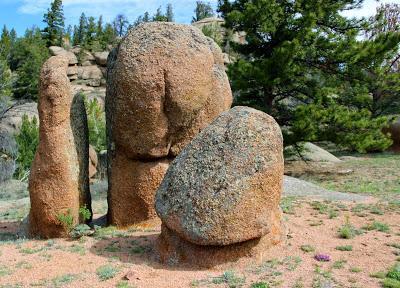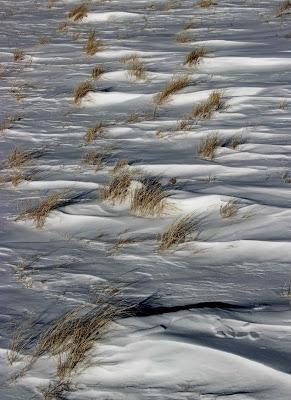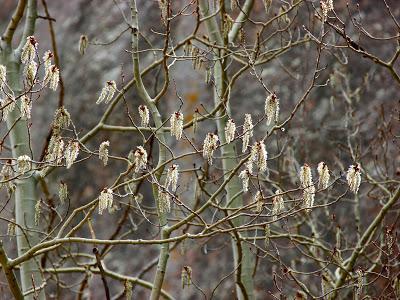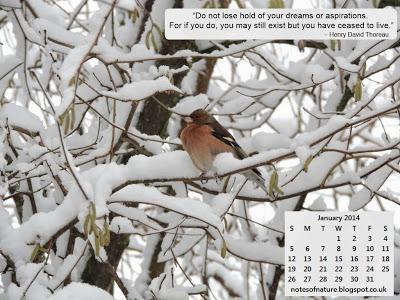
Tors of Sherman granite with spring wildflowers. This was May 2012; for now we can only dream.
In December we had a cross-cultural carnival for geologists (The Accretionary Wedge) and botanists (Berry Go Round). Sadly, attendance was meager. Perhaps it was the holidays -- certainly the case for me, that’s why this summary is a bit late. Hopefully it wasn’t the topic. In any case quality made up for quantity, for one of my top favorite natural phenomena received the most attention -- substrate specificity in plants!Geotripper describes the situation that caused me to fall in love with plants addicted to rocks -- endemics on serpentine, rare plants on rare rock. What’s an endemic? What’s serpentine? He explains both, with great photos.The Life-long Scholar also posted about plants and serpentine, specifically ferns that may be sufficiently addicted to serpentine to serve as clues to geologic structures otherwise hidden by all that pesky vegetation.My current favorite edaphic endemics are the subject of my post about calciphilic plants, those that seem be restricted to limestone or dolomite. I’m not as lucky as students of the serpentine flora. Even though there’s a lot more limestone and limestone-loving plants in the world, literature and knowledge are sparse compared with serpentine.

Serpentine ecology has literature to die for! (click on image to see just a few examples)
Colorado Lichens (and Friends) writes about a “plant” named for its habitat: Rock Tripe. This group of lichens includes a species that may have set the course of our county (USA)! They’re certainly photogenic in any case. I’m glad to have learned about this site “speaking of lichens mostly, sometimes mosses and other cryptogams.” In addition to blog posts, it has lots of information about lichens, something I’d like to learn more about. I was especially happy to find a tribute to substrate specificity: Lichens and Rocks, a post in progress.Lockwood of Outside the Interzone posted a good example of the curious and puzzling patterns of discontinuous distribution that plants present to us. And we can’t resist asking ... why?! In this case, why are there trees on only one slope of the crater?Lockwood also contributed a post about amazing root systems of large spruce trees now exposed on a beach in Oregon. These massive roots are all that’s left of the trees. Geology, specifically plate tectonics, is to blame!

We hate eucalyptus trees for replacing stands of native California live oak, but love them for providing habitat for monarch butterflies. Photo by Benson Ricks, from Pismo Beach Monarch Butterfly Grove.
Dave Coulter at OSAGE + ORANGE brings up Yggdrasil. Don’t know “Yggy”? It’s a giant world tree, an interesting story in itself, and Dave also points out there may well be a connection to ash trees!
The Norns spin the threads of fate at the foot of Yggdrasil.
For my BGR contribution, I submitted the final post in a short series on autumn tree strategies. Autumn seems so very long ago now!
Windrows of snow behind dead stems of bunchgrass, Laramie Basin.
To round out this summary, here are some interesting plant posts I found recently. They’re a bit heavy on photos, but then live plants are what I crave this time of year!Nature of a Man shared wonderful photos of California plants in the field including some serpentine species. The photos are beautiful and natural enough that I almost feel like I’m there ... almost.A Digital Botanic Garden posted exquisite photos of a beautiful legume, the broad or faba bean.In case you haven’t already met, here’s a nice introduction to the Malpighiales, at Catalog of Organisms.Floral odor and heat are how some cycads control pollinators -- telling them not just when to come but also when to leave.Do you know the irresistible and popular titan arums? Have a look at this one that bloomed in August 2012. As its proud parents (US Department of Botany and US National Herbarium) explain, “its irregular flowering times, large inflorescence and foul odor still create a fascinating burst of fecundity.” There's also a fun time-lapse video of the arum and its fans.Favorites of mine, for their elegant flowers, are the milkweeds, featured at Through Handlens and Binoculars (with links to earlier posts).Denver Botanic Gardens explains the Ikebana tradition of flower arranging in Japan.Plants are not always nice, but for a good reason. Defense is critical in a multitude of situations. AoB Blog provides an interesting summary post and a link to Defence on demand: mechanisms behind optimal defence patternsAlso from AoB Blog -- does green always mean photosynthetic? We know it’s not just leaves that photosynthesize, but are all green plant structures photosynthetic?

Quaking aspen get an early start. Before leaves appear, the bark is photosynthesizing and flowers bloom.
Finally ... to all nature bloggers, I wish you the best in 2014. And keep blogging!
Notes of Nature kindly provides monthly desktop calendars. I especially like January 2014.
